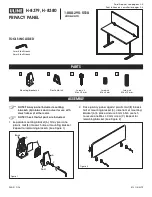
Check
Check
Check and
and
and Lubricate
Lubricate
Lubricate the
the
the Ground
Ground
Ground Rod
Rod
Rod
1.
Check the ground rod (18):
a.
Use Maintenance screen 5 to raise and lower
the ground rod. See
Valve Resets and Test, page 61
.
b.
Activate the ground rod to raise it and
deactivate it to lower it several times. Listen
for the sound of the ground rod making
contact when raising and lowering. In both
cases, the ground rod should fully retract or
extend in less than 2 seconds.
2.
If the ground rod takes more than 2 seconds to
fully retract or extend, use the following steps to
lubricate the cylinder.
3.
Relieve pressure in the system. Follow the
Pressure Relief Procedure, page 30
4.
Slide the electrostatic shield (12) up to remove.
5.
Lubricate the ground rod (18):
a.
Clip the tie straps that hold the bleed resistor
(24) and ground rod together.
b.
Remove the two screws (124), lock washers
(22), flat washers (19), and spacers (123)
that hold the ground rod to the back panel.
c.
Tip the ground rod forward and put 5 drops
of lubricating oil in the small air exhaust hole
at the top of the cylinder.
d.
To reassemble, tip the ground rod back into
the cabinet. Reattach the screws (124), lock
washers (22), flat washers (19), and spacers
(123). Fasten new tie straps around the
bleed resistor and ground rod.
e.
This process may move the wires at the
bottom of the components. After the
reassembly is complete, check the continuity
between the fluid pressure regulator, bleed
resistor, and ground rod.
6.
Reinstall the electrostatic shield (12) inside the
cabinet.
7.
Close the enclosure doors and reapply pressure
to the system.
8.
Repeat step 1. Activate the cylinder 10 times and
then verify that the cylinder speed is less than
2 seconds.
Check
Check
Check the
the
the Bleed
Bleed
Bleed Resistor
Resistor
Resistor
The bleed resistor (24) is used to help discharge the
system voltage and to measure system performance.
If the displayed voltage appears to be inaccurate,
use the following procedure to check the resistance
value of the bleed resistor.
Use megohmmeter Part No. 241079 (AB) and an
applied voltage of 500 V.
1.
Prepare the isolation system for service. See
Prepare the Isolation System for Service, page
89
2.
Use a flat blade screwdriver to open the isolation
cabinet door.
3.
Slide the electrostatic shield (12) up to remove.
4.
Follow the wire from the top of the bleed resistor
(24) to the kV board (428) and loosen the
terminal screw to remove the wire.
5.
Attach the positive lead of the megohmeter to the
wire and touch the negative lead to the threaded
stud at the bottom end of the bleed resistor (24).
6.
Measure the resistance. The resistance should
be between 9 and 11 Gigohms.
• If the value is inside the range, then calibrate
the bleed resistor. Follow the procedure in
Calibrate the Bleed Resistor, page 58
.
• If the value is lower than 9 Gigohm or higher
than 11 Gigohm, then replace the resistor.
7.
Reattach the wire in the terminal screw.
8.
Reinstall the electrostatic shield (12) inside the
cabinet.
9.
Close the cabinet door and use a flat blade
screwdriver to secure the door shut.
Check
Check
Check the
the
the Door
Door
Door Switch
Switch
Switch
A door switch interlock automatically discharges the
system voltage any time the door on the isolation
cabinet (1) is open. Use this procedure to determine
whether the door switch is working properly.
1.
Navigate to Maintenance screen 5 and activate
the grounding rod (N). See
Valve Resets and Test, page 61
2.
Manually depress the door switch. If you hear
the ground rod retract and extend within a few
seconds, the door switch is working properly.
3A8493A
69
















































